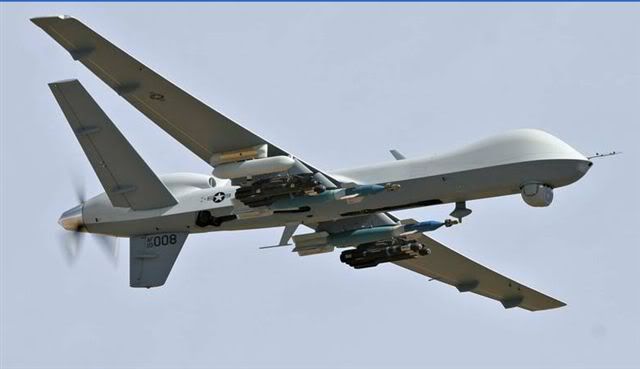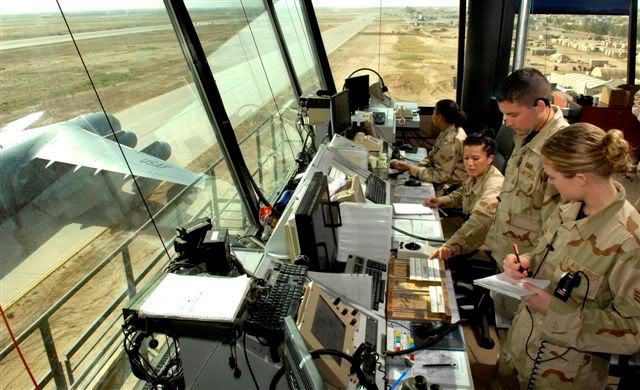The Reaper
The airplane is the size of a jet fighter, powered by a turboprop engine, able to fly at 300 mph and reach 50,000 feet. It is outfitted with infrared, laser and radar targeting, and with a ton and a half of guided bombs and missiles.
 The Reaper is loaded, but there is no one on board. Its pilot, as it bombs targets in Afghanistan, will sit at a video console 7,000 miles away in Nevada .
The Reaper is loaded, but there is no one on board. Its pilot, as it bombs targets in Afghanistan, will sit at a video console 7,000 miles away in Nevada . The arrival of these outsized U.S. "hunter-killer" drones, in aviation history's first robot attack squadron, will be a watershed moment even in an Iraq that has seen too many innovative ways to hunt and kill. That moment, one the Air Force will likely low-key, is expected "soon," says the regional U.S. air commander. How soon? "We're still working that," Lt. Gen. Gary North said in an interview.
The Reaper's first combat deployment is expected in Afghanistan soon where they will fly from Balad Air Base Iraq.
The Associated Press has learned that the Air Force is building a 400,000-square-foot expansion of the concrete ramp area now used for Predator drones here at Balad, the biggest U.S. air base in Iraq , 50 miles north of Baghdad . That new staging area could be completely turned over to Reapers.
Balad Air base tower Iraq.
It is another sign that the Air Force is planning for an extended stay in Iraq , supporting Iraqi government forces in any continuing conflict, even if U.S. ground troops are drawn down in the coming years.
The estimated two dozen or more unmanned MQ-1 Predators now doing surveillance over Iraq , as the 46th Expeditionary Reconnaissance Squadron, have become mainstays of the U.S. war effort, offering round-the-clock airborne "eyes" watching over road convoys, tracking nighttime insurgent movements via infrared sensors, and occasionally unleashing one of their two Hellfire missiles on a target. From about 36,000 flying hours in 2005, the Predators are expected to log 66,000 hours this year over Iraq and Afghanistan
The MQ-9 Reaper, when compared with the 1995-vintage Predator, represents a major evolution of the unmanned aerial vehicle, or UAV. At five tons gross weight, the Reaper is four times heavier than the Predator. Its size 36 feet long, with a 66-foot wingspan is comparable to the profile of the Air Force's workhorse A-10 attack plane. It can fly twice as fast and twice as high as the Predator. Most significantly, it carries many more weapons. UNDER THE RADAR: Air Force ramps up in Iraq
While the Predator is armed with two Hellfire missiles, the Reaper can carry 14 of the air-to-ground weapons or four Hellfires and two 500-pound bombs.
"It's not a recon squadron," Col. Joe Guasella, operations chief for the Central Command's air component, said of the Reapers. "It's an attack squadron, with a lot more kinetic ability." "Kinetic" Pentagon argot for destructive power is what the Air Force had in mind when it christened its newest robot plane with a name associated with death. "The name Reaper captures the lethal nature of this new weapon system," Gen. T. Michael Moseley, Air Force chief of staff, said in announcing the name last September.
General Atomics of San Diego has built at least nine of the MQ-9s thus far, at a cost of $69 million per set of four aircraft, with ground equipment.
The Air Force's 432nd Wing, a UAV unit formally established on May 1, is to eventually fly 60 Reapers and 160 Predators. The numbers to be assigned to Iraq and Afghanistan will be classified. The Reaper is expected to be flown as the Predator is by a two-member team of pilot and sensor operator who work at computer control stations and video screens that display what the UAV "sees." Teams at Balad, housed in a hangar beside the runways, perform the takeoffs and landings, and similar teams at Nevada 's Creech Air Force Base, linked to the aircraft via satellite, take over for the long hours of overflying the Iraqi landscape.
American ground troops, equipped with laptops that can download real-time video from UAVs overhead, "want more and more of it," said Maj. Chris Snodgrass, the Predator squadron commander here. The Reaper's speed will help. "Our problem is speed," Snodgrass said of the 140-mph Predator. "If there are troops in contact, we may not get there fast enough. The Reaper will be faster and fly farther."
The new robot plane is expected to be able to stay aloft for 14 hours fully armed, watching an area and waiting for targets to emerge. "It's going to bring us flexibility, range, speed and persistence," said regional commander North, "such that I will be able to work lots of areas for a long, long time."
So just when they think it's safe to come out of their cave, it still isn't. A Reaper is watching.

